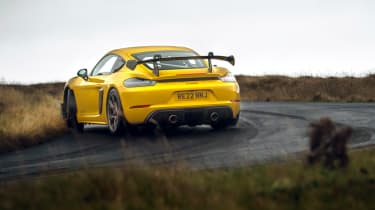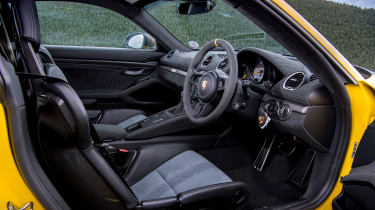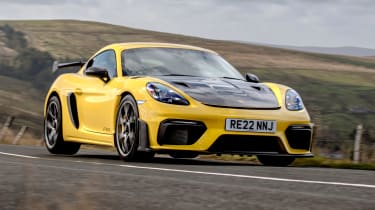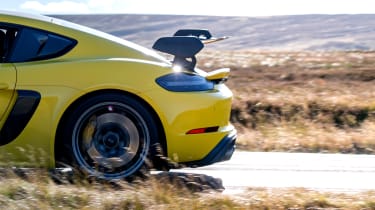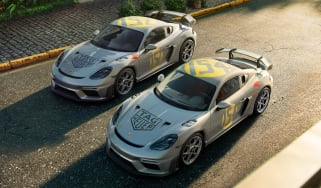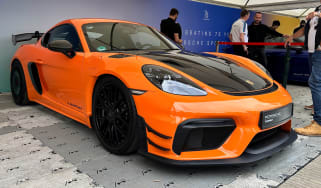Porsche 718 Cayman GT4 RS review: the ultimate mid-engined sports car?
The Cayman GT4 RS is one of the most extreme road-going Porsches of all. It tripped up at eCoty 2022, but later examples we've tried have hit the spot
Some moments just stick in the mind. It’s early October, 2005, and my feet crunch onto the expansive gravel frontage of a rather grand Tuscan hotel, the sort of establishment that until a year or so earlier I’d been completely oblivious about, before I commenced this privileged gig driving and writing about cars. It is my first Porsche new car launch, a real pinch-myself moment as in front of me is a sweeping arc of 987-generation Cayman S models, meticulously lined up, mostly in dazzling Speed Yellow and Guards Red.
Oh how I fell in love with that car on those testing, scenic Italian lanes, but it didn’t take long for dreams to ferment in the mind and to imagine how extraordinary it would be with a 996 GT3’s Mezger-series flat-six nestled amidships. Watching independently brewed Cayman VLN race cars at the Ring in subsequent years didn’t help, but when it came to the factory’s efforts for a hardcore Cayman, things moved at glacial pace.
First there was the 2008 gen1 Cayman Sport; then the lovely 2011 gen2 Cayman R. And then in 2015 something very special indeed, in the form of the 981 Cayman GT4, as Porsche put its conservatism and innate protectiveness of the 911 to one side and made a Cayman with a 911 engine. It was fabulous – so much so that it won eCoty 2015 against formidable and much faster opposition, but still there was a question mark: what about a GT department Cayman that really went all out. Well, wonder no more.
More reviews
In-depth reviews
Reviews
What we couldn’t have known, back in the months following the GT4’s eCoty win, was that Porsche had indeed squeezed a GT3 motor into the middle of a Cayman, as a rather nice birthday present for the then head of R&D, Wolfgang Hatz. To do it, sections of the 981’s body-in-white had to be butchered because the ‘MDG’ engine’s oil tank for the dry sump set-up fouled the bodywork. Fine to do in a prototype, but a complete no-no for a production car. Still, the GT crew knew exactly what they had to do, not just in technical terms but also on a corporate level, and so the car was demo’d to senior company people, who, like GT boss Andreas Preuninger and his team, quickly fell in love with driving the car. With the advent of the 718 model line and a new 992 GT3, the opportunity was there to redesign the engine’s oil tank so that it would fit both cars and the rest, as they say in Stuttgart, ist Geschichte.
And now it’s early one weekday morning, as evo staff photographer Aston Parrott and I load our gear into a GT4 RS and head out into early morning Portuguese traffic to a remote mountain location where we hope we’ll find some curves and scenery to do the RS justice. It feels like so much has been written about this car already, but just in case you haven’t caught the gist so far, the RS uses the latest GT3’s 4-litre engine for 493bhp and 332lb ft of torque in a car that weighs 1415kg, with drive taken through a seven-speed PDK gearbox, the only transmission available. Why 10bhp and 15lb ft down on the GT3? Because the exhaust system has a longer, more convoluted path out of the back of the Cayman compared with the rear-engined 911. The other difference is the intake set-up, which in the Cayman now feeds the engine from both sides of the car, air rushing in through intakes that hitherto on the 718 were the rear side-glass. As we know, it’s a blue-blooded beast of a motor: one that revs to 9000rpm, that exudes naturally aspirated purity and sabre-sharp throttle response, and that also powers the new 992 GT3 Cup and 718 GT4 RS Clubsport racing cars in pretty much exactly the same form.
The chassis is a development of that already found in the fabulous 718 Cayman GT4 – our eCoty winner of 2019, don’t forget. It’s ball-jointed throughout, with its own specific spring and damper tuning, and combines torque vectoring (PTV) with a mechanical limited-slip differential on the rear axle. As with all GT cars, the set-up is highly adjustable. The front brakes have grown by 10mm (to 390mm; 380mm at the rear), with carbon-ceramic discs (410mm front) available at extra cost. A Clubsport Pack – half cage, driver harnesses, extinguisher, etc – is a no-cost option. The expensive Weissach Pack is largely cosmetic (exposed carbonfibre for the bonnet, etc) but it does ‘allow’ customers the option of purchasing magnesium rims at £10,521 a set. The standard rims are shod with 245/35x20 (front) and 295/30x20 (rear) Michelin Pilot Sport Cup 2s (2 Rs are a further dealer option).
Weight-saving measures include front wings and bonnet made from carbonfibre, thinner glass for the rear window, plus less sound-deadening material and thinner carpets. The bottom line is that the RS is 35kg lighter than a PDK-equipped GT4, Porsche estimating that the weight saving is in the order of 60kg but negated in part by some of the beefier componentry. Aerodynamically, the front splitter is adjustable through four stages, and the new swan-neck rear wing through three angles. With further tweaks underneath the car, Porsche claims up to 25 per cent more downforce compared with the GT4.
Most intriguingly, and responding in part to criticism, the gear-set and final drive from the 991.2 GT3 RS has been adopted, along with a number of bespoke parts, to significantly lower the gearing compared with the GT4. Seventh gear is no longer overdrive but the ratio in which the car hits its 196mph top speed.
The ultimate Cayman is still slower around the Ring than a 992 GT3, essentially for three reasons: one, the width of the tyres’ contact patches is limited by the body of the 718 in spite of the new front wings; two, the aero; and three, the 718 uses a mechanical limited-slip differential rather than the GT3’s electronically controlled diff because there isn’t room for the power pack the fancy unit requires. But there’s also a more prosaic reason. While pitched as a ‘proper’ RS model like its 911-based bigger brother that’s due later this year, Preuninger argues that this particular RS moniker also stands for ‘Racing Fun’ (the German for fun is Spaß). A few seconds of pace on track has been sacrificed to make it a road car that entertains more of the time, on more roads. So it is claimed…
The flat-six fires with an aggressive wummph! and from that precise moment it’s hard not to fall completely in love with the GT4 RS. A trifle premature, perhaps? Not really. I imagine you’d be the same with one of Porsche’s naturally aspirated finest sitting mere inches from your ear canals – those six individual throttle bodies hungrily gasping for air; all those lightweight, race-honed components moving in perfect unison; the solid lifters; the 9000rpm rev limit. I’m in ‘Drive’ but I grab both of the paddles behind the wheel to get a temporary neutral and kick the throttle: the engine yelps, the revs flaring without inertia. It is a beautiful noise. Already my nape prickles, and we haven’t even got going yet.
The driving impressions flow like a torrent from the off. As I had already guessed, the engine dominates the car and in an entirely good way. But it’s more than just the engine alone: it’s what the transmission brings to the experience. The RS will hit the rev limiter in second gear at around 70mph compared to 85mph in a manual GT4, and don’t forget the RS has a whole extra 1000rpm of revs to pack into that gear. In third, it’s 100mph plays 115mph. This is much more profound than it looks on paper: it’s a complete sea change in not just the level of performance but how much of that glorious engine you can actually enjoy – with some semblance of responsibility – on the public road. The RS really hits its stride with 4000rpm on the dial, so just imagine the fun you can have while still not travelling at warp speed.
OK, I’ll tell you. The motor gets all snargly in the mid-range, then opens up like the brass section of an orchestra before settling on a single, high-frequency tone over the final 1000rpm that’s so intense, and so loud in the cabin, it’s verging on painful. Photographer Aston Parrott and I both involuntarily burst into fits of childish giggles, before repeating the experience again and again, as you’d do too. But I’d argue that even better are all the bits in between those extremes. Sure, it’s rabidly quick – 0-62mph takes just 3.4 seconds – but it’s the way every last millimetre of throttle movement elicits a subtly different response from the engine. A different rate of acceleration, yes, but also a different sound, from the furious gasping for air as you lead in, to the gradual opening up of tone as those six throttle bodies widen like the mute being gradually removed from the mouth of a trumpet. You really can play tunes on this engine.
Its infinitely variable tone, timbre and resonance, organic and authentic, makes a mockery of the sort of flat, often-augmented or entirely fake noise we’ve come to expect from modern turbocharged supercars – and of course EV hypercars – and mean that the RS’s actual numbers are somehow irrelevant. It’s fast, sure, but there’s a lot more to it than that. Be in no doubt, it’s right up there with other four-wheeled orchestras such as BMW’s E46 M3 CSL and Ferrari’s 458 Speciale.
Porsche’s mastery of its PASM damping means that while it feels taut and stable, it’s rarely crashy or uncomfortable on well surfaced roads. It’s reasonably subdued at a cruise, too, but any incline or any need to increase speed immediately brings that engine note flooding into the cabin. Despite the sensational, tuneful noises, you eventually end up wishing for a less full-on soundtrack on a long drive, partly thanks to the short gearing that gives the RS an 'always-on' feel. Bizarrely, it reminds me of driving 1980s French hot hatches in this regard; the RS is never sleeping, it’s always ready to go, unapologetically, unambiguously. This particular car has the infotainment system delete and I couldn’t care less.
We’ve arrived on location, and within the confines of rock faces, undergrowth and low-hanging trees I’m expecting the RS to be intense, and it is. The road’s surfaces are good, but they’re extremely narrow despite having a dotted line down the middle, with little room for error. What is immediately obvious is the sheer precision of this car: the steering really is quite beautiful, telling you absolutely everything you need to know but filtering out what you don’t. It’s a slightly more prescriptive approach than a McLaren with its hydraulically assisted rack, but no less enjoyable. Adjustments at the wheel can be little more than thought processes channelled into deft nudges on the suede-effect rim.
The outright level of grip is predictably very high, but it’s the balance of the car that really breeds confidence. As with all 718s, you can sense the engine is tucked up to the bulkhead right behind you, and mounted low, because the car has that pure mid-engined feel where it moves of-a-piece without any obvious inertia or weight to manage. Actually loosening the tyres’ grip in the dry takes some provocation, not because the engine is short on grunt, but because the RS wants to find drive. Obviously, it’s not like a BMW M4, where oversteer can be had with a mere flex of the right foot: in the RS it helps if you’re working up nearer the limits of grip already, or if you’ve given it some aggressive inputs to get it up on its toes. Then it really does want to move around, but it’s controllable all the same as long as you’re accurate with the inputs you make – and that’s made all the easier thanks to the sharpness of the throttle control. Brake feel is exemplary, and the sheer stopping power of the brakes is something that almost hurts when you really lean on them.
Do I miss the manual gearbox? Well, while I’ll always naturally default to the idea of a manual, the downshifts in this PDK have to be experienced to be believed. They come not so much with a blip, rather a spit or crack, and it seems inconceivable that the crankshaft can spin up and down that quickly. It becomes an integral part of the driving experience, and while I’m sure a manual would bring other qualities into play, I never find myself pining for an extra pedal.
It's fair to say that after our fairytale first drive, evo has had a troubled, slightly confusing relationship with the GT4 RS. When we first drove it in the UK at eCoty 2022, our adoration of the RS was – quite literally – shattered by its ruthless, uncompromising and downright jarring feel over lumpen, craggy B-roads. A fifth place finish doesn't sound terrible, but given the enormous weight of expectation behind the Cayman, it was deeply disappointing.
We've since driven a later-build GT4 RS and the magic we felt when we first drove it appears to have returned. The ferocity and precision of the engine, gearbox and chassis melded with a firm but compliant ride quality that made pretty much any road – and not just newly-surfaced ones – a joy. Porsche hasn't officially confirmed whether the later car had a different suspension setup to the example we drove previously, but it certainly felt measured and fluid in a way that doesn't square with our impressions from eCoty. Put simply, it felt like the car we thought – and hoped – the GT4 RS would be. As for the noise? It'll still have your ears ringing to the sound of that flat-six after a long drive, whether you like it or not.
Prices and rivals
As you can probably tell, the GT4 RS is quite some car. You can inflate the £123,000 list price with options and personalisation, or you can have it just as it is, and that’s also perfectly fine. And while there will inevitably be the outcry that actually securing a build slot is impossible unless you’ve a very prolific customer, so Porsche insist that there are many builds slots for a few years to come, and if buyers are patient then they will get their cars in due course. Time will tell on that one, but even if it’s a long time coming, much like those dreams back in 2005, it has been, and will be, so very worth the wait.
> Porsche 911 GT3 RS review – is this peak 911 road car?


